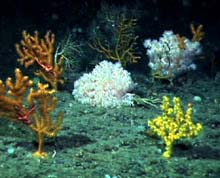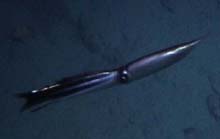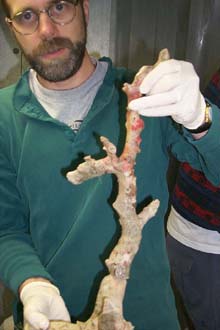Three Strikes
September 11, 2001
Karl Stanford, Teacher
Lincoln Academy, Newcastle, Maine
O mother, mother, hear the sea! It calls across the sands; I saw it tossing up the spray, like white imploring hands. -- Mary Artemisia Lathbury
![]() Watch a video as Alvin ascends the steep west wall of Oceanographer Canyon.
Watch a video as Alvin ascends the steep west wall of Oceanographer Canyon.
The scientists were dealt a triple blow today. First, word came from the captain that the combination of 15-ft seas and gusting winds made the Alvin's safe launch and recovery impossible. Then, Alvin technicians reported a short-circuit in a fitting that carries wires through the sub's spherical titanium pressure hull. Even if the weather had cooperated, Alvin was laid up for at least a day, so it remained safely stowed in its hangar. The final blow came during the 9:30 am briefing, when the chief scientist, Dr. Les Watling, brought chilling news of the terrorist attacks on New York City and Washington DC, and the crash of a fourth hijacked jet in Pennsylvania.
Dr. Watling and Susanna Fuller were scheduled to dive into Lydonia Canyon today, but the safety of the submersible and its crew is always the first priority. The disappointment about losing the dive day was overshadowed by the shock of the day's events back on the mainland. We gathered around a crackly speaker on the mess deck, listening to the fragmented account of the attack. The details were still coming in, but it was apparent that the United States had suffered the most devastating terrorist attack in history. Crew members and scientists tapped out e-mail messages to friends and loved ones, hoping for reassuring replies. Though more than 100 mi out to sea, we were personally involved in the tragedy when we learned that a member of our team had lost her home in the fires following the collapse of the World Trade Center towers. A dose of good news followed, however, as we learned that her husband was safe at work when the attack took place.
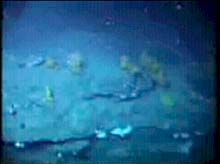
![]() Images taken from Alvin as it ascends the steep west wall of Oceanographer Canyon, note the distribution of corals near the lip of the terraces. Click image to see a video.
Images taken from Alvin as it ascends the steep west wall of Oceanographer Canyon, note the distribution of corals near the lip of the terraces. Click image to see a video.
The day's work was therapeutic to some; productivity with a measure of distraction. Several hours of digital video had been shot during the Oceanographer Canyon dive. Tapes were duplicated. Video and still image clips were processed and logged. Samples from the dive were marked, preserved, and cataloged. These specimens will be the subject of months of analysis and research once we return to dry land.
Technicians completed the repairs on Alvin. A small amount of seawater had found its way through a seal in the fitting. The diagnostic equipment on the submersible had read a short-circuit, but the repair effort was a success. The weather was the only thing standing in our way for tomorrow's dive on Bear Seamount.
As we gathered for supper on the mess deck, a snowy broadcast from a Boston television station showed footage of the attack. My first impression was that it looked so "Hollywood" -- like a special-effects sequence from an action movie. This time, it was no movie. It was real. The weather here hasn't changed much, but the rest of our world has.
(top)
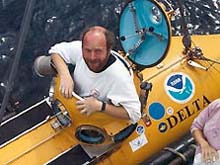
Dr. Peter Auster. Click image for larger view.
Interview with Dr. Peter Auster
Science Director
National Undersea Research Center
University of Connecticut at Avery Point
Ocean Explorer: What are your responsibilities aboard the Atlantis during the Deep East Expedition?
Peter Auster: I am one of the principal investigators on this leg of Deep East. My main area of interest is the distribution and abundance of fishes. In particular, I'm looking at the influence of deep corals on the fish community. There is overwhelming evidence regarding the relationship between shallow coral reef ecosystems and their associated fish, but very little is known about deep species. In shallow coral reef systems, fish generally don't move very far. There is a strong risk of predation, and an individual fish can usually get all the food it needs nearby. The coral provide some interesting habitat structures, and I want to find out more about their role in deep-water systems.
Ocean Explorer: Today was your first dive in the deep submersible vehicle Alvin. What was it like?
Peter Auster: Well, it was wicked cool! I'm not just talking about the ice-water bath I got on deck after I came up, either. I'm a bit of a technology junkie, and being down in a machine like Alvin is pretty amazing. If you are studying deep-ocean ecology, Alvin is how you go to work in the morning. It has cameras, and a manipulator arm, and viewing ports. Alvin provides windows on a world very few people get to see. It gives us a new view of the underwater landscape. You are hovering along the wall of a submarine canyon, and you see all the patchiness of the environment down there. You'll go up a canyon wall and there will be one area with corals in it because it needs a rocky substrate to attach to.
Ocean Explorer: The water temperature at the bottom was near 3 degrees Celsius. Did you get cold being down for nearly 6 hrs?
Peter Auster: Actually, it wasn't too bad. In some submersibles, it can get very cold during a 6- to 8-hr dive, but since they put some new computers and monitors in Alvin, it's quite a bit warmer. Power consumption is a big concern on a sub, and you can't afford to use battery power to heat the sphere. The electronic gear gives off a lot of heat, though, and it makes it more bearable. Condensation is still a problem. With three people breathing out water vapor in a closed, cold metal ball, you constantly have to wipe the viewing ports with a towel if you want to see what's going on.
Ocean Explorer: Did you see any interesting fish on the way down, or at the bottom?
Peter Auster: To me, all fish are interesting. Often, we only get to see some of these fish on deck when they come up in a net. The opportunity to view any fish in their natural habitat is always a treat, and being able to view these deep-water fish is even better!
Ocean Explorer: Did you always want to be a marine biologist? How did you choose this as a career?
Peter Auster: No, not always. I remember when I was in 5th grade, I was like a lot of kids and wanted to be an astronaut. The idea of going into space and exploring was really intriguing. Being an astronaut is a pretty big stretch for anyone, and being in space is a very brief moment in one's career. As a marine biologist, I get to explore in the other direction -- down. Life down there is everywhere. There are more than 24,000 species of fish. They are the most successful group of vertebrates on Earth! Everywhere you look are incredible examples of evolution. It is so much better than being an astronaut!
Interview by Caren A.D. Menard of the Ocean Explorer Team.
(top)
Interview with Dr. Scott France
Assistant Professor in Biology
College of Charleston
Ocean Explorer: Was your Deep East dive different from your other dives on Alvin?
Dr. Scott France: Yes, it was. This dive was my first dive in the Atlantic Ocean. Other dives I made were in the Pacific. My dives in Alvin, thus far, have been to hydrothermal vents, where we focused our research in a very small area. On the canyon dive we explored a larger area. Hydrothermal vents are aligned on the top of undersea mountains and the bottom is black basalt with little or no sediment. A vent site also has unique communities of organisms and is a very different habitat. So this canyon dive explored a very different type of habitat, one with sediment. I also now know what to expect when in a submersible. For example, there is a strict protocol that needs to be followed. The cabin is tightly spaced, so it is not uncommon to have to sit with someone's legs in your face. I am prepared for the logistics of working with the camera on the Alvin. And I am always prepared with a notebook for taking notes. This way, I can focus on the science I want to do.
Ocean Explorer: What were you looking for on this particular dive? What did you find?
Dr. Scott France: During our dive, I was looking for dense patches of octocoral colonies. Our main objective was to find out how many of these colonies are down there and where they are. While down on the sea floor, we took samples of branches from the colonies for the purpose of identification through genetic analysis. It was a successful dive as we photodocumented many invertebrate and fish species on video, and we brought back tissue samples from seven different corals.
Ocean Explorer: How did you prepare the morning of the dive?
Dr. Scott France: Before diving in a submersible, you have to fill a pillowcase with things you want in the sub. In my case, I packed a thick cotton sweater, cotton sweats, cotton long-sleeved shirt and wool gloves and socks. The main reason for "all cotton" is that no synthetics are allowed in the sub, because they are a fire hazard. The evening before the dive, I prepare data sheets for the specific details I will be looking for in my research. I also bring along notes on coral shapes to make the identification of species a little easier. Most of all, I have a decent breakfast (not too big), and I use the facilities about three times, just to make sure.
Ocean Explorer: What is it like traveling to the sea floor in a submersible?
Dr. Scott France: I find traveling to the sea floor exciting. It is very dark once you get past the photic zone, yet you encounter some alien-looking species on the way down. At this time, the outside lights are turned off, and the scientists and the pilot discuss protocol. What I like to do is look out the porthole. Sometimes I see green and yellow bioluminescent organisms floating by. What overcomes me, as I travel down, is a sense of anticipation and of the unknown.
Ocean Explorer: What does one have to do to get the chance to dive in the Alvin?
Dr. Scott France: The divers in the Alvin are generally either scientists or pilots. Generally, the scientist is a type of oceanographer. The submersible pilot often has a degree in engineering. The scientist in the submersible will have an advanced degree and often a PhD in biology, geology, or chemistry. Graduate students also have opportunities to dive. If you are doing research, you have to write to the National Science Foundation and request funding for support to complete your study aboard ship and to use the submersible. These arrangements are all made at least a year in advance of the dive.
Interviewed by Karl Stanford of the Ocean Explorer Team.
Sign up for the Ocean Explorer E-mail Update List.

































